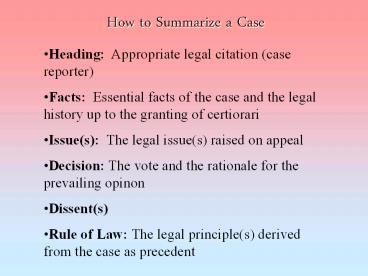How to Summarize a Case - PowerPoint PPT Presentation
How to Summarize a Case
Facts: Essential facts of the case and the legal history up to the granting of certiorari ... New York Times v. United States, 403 U.S. 713 (1971) ... – PowerPoint PPT presentation
Title: How to Summarize a Case
1
How to Summarize a Case
- Heading Appropriate legal citation (case
reporter) - Facts Essential facts of the case and the legal
history up to the granting of certiorari - Issue(s) The legal issue(s) raised on appeal
- Decision The vote and the rationale for the
prevailing opinon - Dissent(s)
- Rule of Law The legal principle(s) derived from
the case as precedent
2
Freedom of Speech and Freedom of the
Press Sedition and Censorship
3
Sedition
Sedition Act of 1918 upheld in a number of
decisions, including Schenck and Abrams, but
lapses in 1920s Smith Act of 1940 advocate,
abet, advise, or teach the duty , necessity,
desirability, or propriety of overthrowing or
destroying the government of the United
States upheld, in principle, in Yates v. United
States (1957), but the speech must urge someone
to commit illegal acts
4
Sedition
The States Unconstitutional Ashton v. Kentucky
(1967) Government officials cannot use sedition
laws to curb public criticism Brandenburg v.
Ohio (1969) defines difference between
advocacy and incitement
5
Prior Restraint
CENSORSHIP!
6
Prior Restraint
- Near v. Minnesota,
238 U.S. 697 (1931) - New York Times v. United States, 403 U.S. 713
(1971) - United States v. The Progressive, 467 F. Supp.
990 (W.D.Wis. 1979) - Hazelwood S.D. v. Kuhlmeier,
484 U.S. 260 (1988)
PowerShow.com is a leading presentation sharing website. It has millions of presentations already uploaded and available with 1,000s more being uploaded by its users every day. Whatever your area of interest, here you’ll be able to find and view presentations you’ll love and possibly download. And, best of all, it is completely free and easy to use.
You might even have a presentation you’d like to share with others. If so, just upload it to PowerShow.com. We’ll convert it to an HTML5 slideshow that includes all the media types you’ve already added: audio, video, music, pictures, animations and transition effects. Then you can share it with your target audience as well as PowerShow.com’s millions of monthly visitors. And, again, it’s all free.
About the Developers
PowerShow.com is brought to you by CrystalGraphics, the award-winning developer and market-leading publisher of rich-media enhancement products for presentations. Our product offerings include millions of PowerPoint templates, diagrams, animated 3D characters and more.































